Leopard Gecko Care Sheet
Common names: Leopard Gecko Scientific Name: Eublepharis macularius DescriptionDescription: Leopard Geckos get their name from their patterning, which is quite reminiscent of a Leopard with black or dark brown markings on a yellowy-gold body. This distinctive colouring is not always present on many leopard geckos kept in captivity however, as captive breeding has created such a extensive range of morphs that these geckos can be found in a wide variety of colours and pattens. Leopard Geckos are a relatively small species of lizard. They have long bodies, large eyes, characteristic faces and long wide tails, making them quite an attractive species. Size: Leopard Geckos generally grow to between 18 to 28 cms (7-11 inches) in length. Life span: Leopard Geckos can live up to 10 – 15 years with appropriate care. Origin: Leopard Geckos are found throughout North-West India, Pakistan, Afghanistan, Iraq, Iran and Southern Asia. Habitat: Leopard Geckos are a terrestrial species, so spend the majority of their life on the ground. Their natural habitat includes grasslands and arid desert, which are both dry and rocky. Interesting fact about Leopard GeckosLeopard Geckos have the ability to drop their tails when threatened or captured by a predator. This is called Autotomy and works as a survival tactic because the tail will continue to wiggle after being dropped, which distracts the predator and gives the gecko a greater chance of escaping. If successful the gecko’s tail will regenerate within 1-2 months, although the new tail may be smaller than and not as attractive as the tail that was lost. TemperamentLeopard geckos are highly inquisitive and lively geckos, but are nocturnal, so are more often seen exploring their tank in the evening and at night. They make an ideal first lizard as they are relatively easy to care for and they can become quite tame with regular interactions with their keeper. They are a communal species, so can be kept in groups, but males that are housed together will fight for dominance, occasionally to the death, so it is best to always keep males singularly. Males and females can be housed together, although this may sometimes cause problems for the female who may be pestered by the male for breeding purposes. It is advisable to keep males and females separate so as not to exhaust the female, but this is also beneficial because it allows you to have greater control over the frequency of clutches. Multiple females should be fine if housed together, as long as all their care needs are met. Keeping leopard geckos in a group would mean that you would need a larger vivarium and plenty of hides to ensure that all your leopard geckos have room to move around and have many places to feel safe. Things to consider before purchasing a Leopard Gecko
HousingAdult leopard geckos are quite lively and appreciate a large vivarium. A 2.5ft (approx. 30inch) vivarium or a 20 gallon tank should be adequate for a adult leopard gecko, but the more space you can give them the better, especially when housing multiple leopard geckos together. Leopard geckos do well in a dry savannah (woodland) or desert type set-up. Your Vivarium should contain:SubstrateThere are various substrates that are sometimes recommended for use with leopard geckos including sand, woodchips, and pebbles, but most keepers prefer not to use loose substrate due to the risk of impaction if it is digested. This is particularly important when providing a substrate for juvenile or sub-adult leopard geckos, as they are more susceptible to ingesting loose materials than fully-grown adults. Ideally it is better not to use these types of loose substrate at all, and reptile/cage carpet, lino or vinyl tiles are a very good alternative. A simpler, but less attractive substrate is paper towels or newspaper. These are cheap, fit for purpose and easy to clean if they become soiled. Somewhere for your Leopard Gecko to hide
Logs, stones and cork bark make good natural looking additions to your vivarium and make great hiding places. Live succulent plants can also be used, but be aware that some live plants may be harmful to your leopard gecko, so researching reptile safe varieties is very important when using live plants. Any Stones or branches that are collected from the wild need to be debugged by soaking first in chlorine & water solution, rinsed thoroughly and soaked again in clean water, then left to dry in the sun before placing in your leopard gecko’s vivarium. A change of sceneryLeopard geckos are very inquisitive animals and like to explore new surroundings. Once in a while change the layout of the vivarium and this will keep your leopard gecko from becoming bored. You will notice once you put your leopard gecko back in the tank it will start to re-explore its new surroundings. WaterAll Lizards, including leopard geckos need fresh water daily. A large water bowl should be placed within the vivarium, which is changed frequently to avoid the build up of bacteria. HumidityLeopard Geckos do not require high humidity, but a little more than normal room humidity should be maintained. Misting the tank regularly with water in a spray bottle should keep the humidity around 50-70%. HeatLeopard geckos are cold blooded and get heat from their surroundings. In the wild lizards would bask in the sun to keep warm or move to a shady spot if they are too hot, this is called thermo-regulation. The ideal temperature for you gecko's vivarium is a temperature of 27-32°C (80-90°F) with a slight drop at night time.
LightingLeopard geckos do not need the addition of UV lighting as they are a nocturnal species. General CareFeeding
Leopard geckos should be fed every other day with a varied diet of appropriately sized gut-loaded insects, including mealworms, crickets, small grass hoppers, wax-worms and Calci-grubs. Feed 5 or 6 insects per gecko per feeding. The live food should be dusted with a good D3 and calcium supplement every other feed for adults, but with calcium being especially important during growth, juveniles should be fed daily with supplements added at every feed. Some keepers permanently leave a small bowl of calcium supplement within the vivarium to ensure that their leopard geckos have access to vital nutrients whenever required. As an adult your leopard gecko should be able to feed on the occasional pinkie mouse, but you should regard this as a treat item as regular feedings on mice can cause your gecko to become obese. CleaningYour leopard gecko’s vivarium should be inspected and spot cleaned daily when changing the water. Leopard geckos tend to defecate in the same place regularly, so any faeces should be easily found and removed. Every two to three weeks clean out the tank completely and sterilize the vivarium using a reptile friendly disinfectant. You will also need to remove and sterilise any décor, ready to replace back in the vivarium when it has been cleaned. Your geckos should be moved to a temporary tank during the cleaning process. Shedding/SloughingLeopard geckos shed their skin at regular intervals as they grow. The old skin is pushed off is normally eaten by the gecko. Your leopard gecko should go through this process every 3-6 weeks, dependant on its rate of growth.
After your leopard gecko has shed its skin, you should make sure that all traces of the old skin have completely come away from your leopard gecko’s body. If not, you may need to assist your gecko by removing any retained shed by either gently rubbing your leopard gecko with a towel after a soak in warm water or by working the skin away with a cotton bud. This is particularly important around awkward areas like toes and the tip of the tail. Retained skin can interfere with the blood supply on a part of your leopard gecko’s body if it is not removed, so it is important to be aware of this to avoid your leopard gecko losing a part of itself and becoming deformed. HandlingLeopard Geckos seem to appreciate being handled, but care should be taken to ensure that they are held gently, but tightly to avoid any incidents if the leopard gecko wriggles free. The main concerns include dropping your leopard gecko from height, losing your leopard gecko or accidently grabbing your leopard gecko by the tail causing it to be dropped. All these incidents can be avoided by adequately supporting your gecko, handling in a safe area and supervising children whilst handling. It is advisable to wash your hands both before and after handling your leopard gecko. SexingSexing your leopard geckos is difficult unless your gecko is over 6 months of age, because juvenile males do not have distinctive features before this time, so may be mistook for a female. The easiest way to determine sex is by looking at the underside of your leopard gecko for a V-shaped row of pores and a distinct bulge near the vent. Males develop this bulge to house their hemipenes (duel sex organs), so if your gecko does not have the pores or the bulge then it is most probably female. BreedingThe breeding season for leopard geckos is generally the spring and summer months, after about a 2 month conditioning period in the winter where light, temperature and food have been reduced. Leopard geckos reach sexual maturity at about 1 year of age and they should be a good health and weight before they are allowed to breed (above 50 grams). This is important because breeding underweight or unhealthy leopard geckos not only puts your adults at risk as they are more susceptible to breeding complications, but it would also greatly reduce your chances of producing viable offspring. Females that are housed with a male should lay several clutches per year, but if you house your leopard geckos separately then the female can be introduced to the male’s vivarium, which gives you more control over the frequency of the clutches. Each clutch should have approximately 2 eggs, which the female will lay in a secure, damp spot, which should be provided in the form of a nesting box. It is recommended that after laying the female should be separated from the male to allow her the time to rest and gain weight without the interference from the male who will be eager to mate with her again. Once the eggs have been laid they should be removed and incubated on vermiculite in 70-80% humidity. Leopard geckos can produce incubation dependant young, which means that the sex of the hatchling leopard geckos can be determined by the temperature that they were incubated at. An incubation temperature of around 26°c (79°F) would produce mainly females, while 32°C (90°F) would make males more likely. It is advisable to keep the temperature at around 30 °C (86°F) if you would like a more even distribution of the sexes. Hatchling leopard geckos should be kept separate from the adults and fed on appropriately sized insects, dusted regularly, to ensure healthy growth. Any more Questions?This care sheet is a simple step-by-step guide to successful Leopard Gecko keeping, but if you have anymore questions or need more specific information about the care of Leopard Geckos, please enter our forum. It is a useful resource where you can ask other members to share good practice and also talk about your experiences of being a Leopard Gecko keeper.
|
|

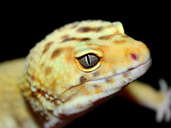
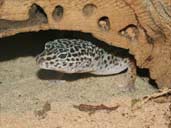
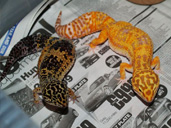
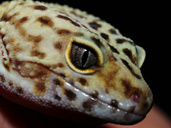
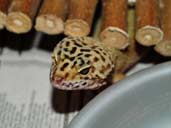 All Lizards require somewhere to hide and may become stressed if this is not provided. This could be a commercially made lizard hide from a specialist reptile shop or simply a plant pot on its side, which is low cost but easily cleaned. If you are keeping multiple leopard geckos in a vivarium then it is important to provide a hide for each of the leopard geckos housed.
All Lizards require somewhere to hide and may become stressed if this is not provided. This could be a commercially made lizard hide from a specialist reptile shop or simply a plant pot on its side, which is low cost but easily cleaned. If you are keeping multiple leopard geckos in a vivarium then it is important to provide a hide for each of the leopard geckos housed.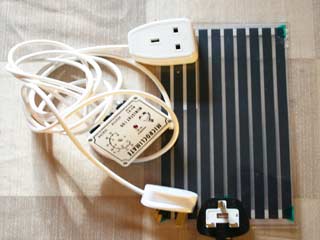 Heat mats should only cover between a third and a half of the floor space to allow your leopard gecko to thermo-regulate. This heat mat should be regulated by a thermostat to ensure that it does not overheat. Since a heat mat should provide sufficient heat to keep your leopard gecko happy, a basic mat stat, like the Microclimate Ministat 100 or the Habistat Mat Stat, should be appropriate. These thermostats are available from reptile shops and online, are relatively cheap, and will ensure the heat source is regulated at a safe level.
Heat mats should only cover between a third and a half of the floor space to allow your leopard gecko to thermo-regulate. This heat mat should be regulated by a thermostat to ensure that it does not overheat. Since a heat mat should provide sufficient heat to keep your leopard gecko happy, a basic mat stat, like the Microclimate Ministat 100 or the Habistat Mat Stat, should be appropriate. These thermostats are available from reptile shops and online, are relatively cheap, and will ensure the heat source is regulated at a safe level.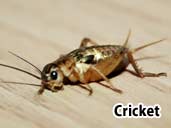
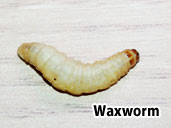
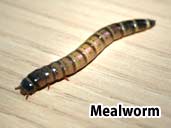
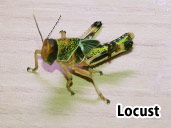
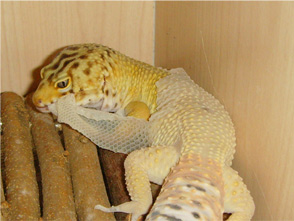 Most leopard geckos will handle a shed without any need for extra help, but if you want to assist your gecko during this time you should try to raise the humidity in your vivarium to help it loosen it's skin. You can do this by placing a larger water bowl in the vivarium so that your gecko has the opportunity to soak itself if desired. You can also lightly mist the tank with water to help raise the humidity. Another useful tactic is to place a humidity box in the vivarium. This can be a sandwich box with a hole cut in the top filled with damp sphagnum moss. Your leopard gecko should appreciate the extra humidity and it will make the shedding process easier.
Most leopard geckos will handle a shed without any need for extra help, but if you want to assist your gecko during this time you should try to raise the humidity in your vivarium to help it loosen it's skin. You can do this by placing a larger water bowl in the vivarium so that your gecko has the opportunity to soak itself if desired. You can also lightly mist the tank with water to help raise the humidity. Another useful tactic is to place a humidity box in the vivarium. This can be a sandwich box with a hole cut in the top filled with damp sphagnum moss. Your leopard gecko should appreciate the extra humidity and it will make the shedding process easier.